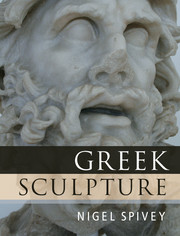Book contents
- Frontmatter
- Dedication
- Contents
- List Of Figures
- Preface
- Note
- 1 Introduction: the Study Of Greek Sculpture
- 2 The Greek Revolution
- 3 Daedalus and the Wings of Technê
- 4 Anathêmata: Gifts for the Gods
- 5 Heroes Apparent
- 6 Temple Stories
- 7 In Search of Pheidias
- 8 Revealing Aphrodite
- 9 Royal Patronage
- 10 Portraits and Personifications
- 11 Graecia Capta
- 12 Afterlife
- Index
7 - In Search of Pheidias
Published online by Cambridge University Press: 01 December 2014
- Frontmatter
- Dedication
- Contents
- List Of Figures
- Preface
- Note
- 1 Introduction: the Study Of Greek Sculpture
- 2 The Greek Revolution
- 3 Daedalus and the Wings of Technê
- 4 Anathêmata: Gifts for the Gods
- 5 Heroes Apparent
- 6 Temple Stories
- 7 In Search of Pheidias
- 8 Revealing Aphrodite
- 9 Royal Patronage
- 10 Portraits and Personifications
- 11 Graecia Capta
- 12 Afterlife
- Index
Summary
Opus LX of the Dutch-born Victorian painter Sir Lawrence Alma-Tadema may not rank as an absolute masterpiece, but it evokes a moment in history that naturally appeals to the artistic imagination. Pheidias showing the Frieze of the Parthenon to his Friends (Fig 7.1) recreates, with studied detail, a supposed ‘private view’ on the Akropolis c. 440 BC. Pheidias, scroll in hand, stands before the freshly finished relief, while sundry prominent Athenians – Perikles with Aspasia, and (in the foreground) Socrates with young Alcibiades – stand on scaffolding planks to inspect the piece: as well they might, since, for all its bright paintwork (boldly yet credibly recreated by Alma-Tadema), this is a work of art which will be very difficult to see properly once the scaffolding is down.
Here is a powerful image of Pheidias the immortal sculptor: Pheidias the divino artista, the ‘great master’ – the paragon of creative energy in that nursery of genius, Periklean Athens. This is the Pheidias apostrophized in the lines of a sonnet celebrating the arrival of ‘the Elgin Marbles’ in London:
Pheidias! thou hast immortalized thy name
In these thy handy-works, and they will tell
Loud as ten thousand thunderings thy fame
Wherever truth and beauty deign to dwell.
(The sonnet is from The Gentleman's Magazine, January 1818, 65; the probable author is Benjamin Robert Haydon, a painter who led the way in recognizing the exceptional beauty of the Parthenon sculptures – despite their battered state.)
Amateurs and experts became united in their enthusiasm. In 1871, John Ruskin saluted ‘the noble hand’ responsible for the Parthenon frieze, claiming that the artistry of Pheidias was directly apparent in the work: ‘you may recognize the decision of his thought, and the glow of his temper, no less in the workmanship than the design’ (my italics).
This is praise born of true esteem. So it seems mean-spirited to make the pedantic observation that not a single work survives that can be certainly attributed to an artist called Pheidias. As we shall see, there is a possibility that the Riace Bronzesmay be from the workshop of Pheidias; and there is a sense in which Alma-Tadema could rightly show one man standing to take credit for the Parthenon frieze: someone – say Pheidias, though no ancient source specifically attests this – probably sketched its design, even if some forty other sculptors actually carved it.
- Type
- Chapter
- Information
- Greek Sculpture , pp. 174 - 193Publisher: Cambridge University PressPrint publication year: 2013



